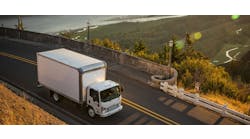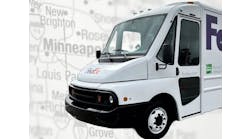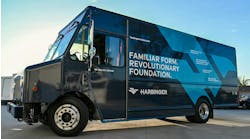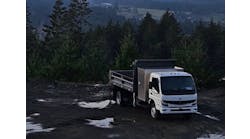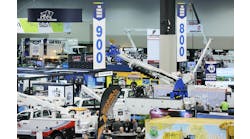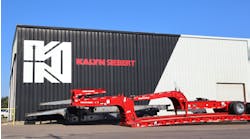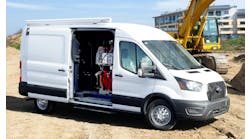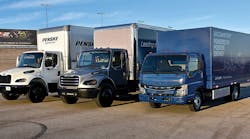The medium-duty truck market remains at record levels and while forecasters see few near-term risks, those in the work truck industry need to be aware of some fundamental market shifts. Specifically, body builders and upfitters should be prepared for the “the Amazon effect” and Final Mile delivery demands, for the rising need for advanced safety and telematics systems in medium-duty applications, and for emerging electric vehicle technology.
But speaking too broadly about the medium-duty truck market is asking for trouble, or at least sowing confusion.
“We all talk about medium duty in a different way,” said Jonathan Starks, chief intelligence officer for FTR, in introducing a Transportation Conference panel discussion focused on new opportunities in the historically steady medium-duty space. The panelists confirmed the assessment.
Jon Morrison, president, Americas, WABCO North America, details the complication for just his company: For WABCO, Class 6-7 truck, Class 6-7 bus, and Class 4-5 are treated as different segments. Paul Jarossy, director, marketing and business development, Morgan Truck Body, notes that Class 6 is their “bread and butter,” but demand is trending to smaller trucks. And for Steve Gilligan, vice president, product and vocational marketing, Navistar Inc., it’s the job of the OEM to deliver whichever vehicle customers need.
Nonetheless, the panel was able to outline a consensus.
“For us, what’s been really nice is the growth in medium duty has been very steady, very deliberate,” Morrison said. “So from a planning point of view, obviously, how we look at the different requirements of that market has been fairly straightforward to manage—not a big change like we’ve seen in the Class 8 increase. So that’s good for us as a supplier.
“When we look at the medium-duty segment, it’s a bunch of everything. There are a lot of different pockets of opportunity. Because we have a favorable environment right now, we’re seeing opportunities to increase content on various segments, like the recreational vehicle side, the fire truck side, or even on some of the vocational or straight truck applications, we’re seeing receptivity.”
Jarossy concurred, noting that Morgan’s growth has exceeded the market’s in recent years.
“We already have a large market share of national leasing fleets, but we’ve been able to enter the lighter-duty segment as well and expand our smaller, contractor-type bodies [share],” Jarossy said.
The extended period for growth in the medium-duty market has allowed Morgan to add plants and capacity, and to take advantage of its nationwide production network; but the body builder is now taking a year-by-year approach to strategic planning.
“Beyond 2019, everything is changing so fast,” he said.
To keep up, the product development team at Navistar’s International Trucks must understand how customers are using their equipment.
“More and more, we’re actually putting people out in the operating environment,” Gilligan said. “We’re trying to become experts in that application, and incorporate descriptions and pictures and videos of how that vehicle is being used to optimize the design. It’s always a learning experience. There’s a huge difference between what you might hear from a purchasing manager and what you might get from a person actually driving a delivery or a service vehicle.”
The shift to online retail, and the resulting demand for Final Mile delivery, is a huge part of the changing marketplace.
“You hear the term all over the place right now, but we’ve been building medium-duty trucks for 65 years, so we’ve been in Final Mile,” Jarossy said. “This door-to-door ‘Amazon effect’, the home grocery delivery, that is where we’ve spent quite a lot of time over the last couple of years developing solutions. Not just delivering mattresses, but delivering frozen and fresh and ambient [temperature] groceries to somebody’s doorstep is very difficult to solve—but it’s something that is happening and it’s not going to go away.”
Anecdotally, Morrison mentions that the previous weekend his doorbell rang and when he answered a package was on his doorstep; a woman was hurrying back to a car to continue making deliveries.
“There’s probably going to be a redistribution of how that freight gets delivered, but generally the amount of freight is increasing, the number of transactions is increasing—so that’s all good for that segment of trucking.”
Indeed, Gilligan suggests that for most home delivery products, Class 6-7 trucks are not appropriate, and he points to recent orders by Amazon for Class 2-3 vehicles.
“But some of our customers are still using Class 4-7 trucks to deliver in that Final Mile, so we have to understand what’s happening, what’s being hauled, and whether or not it’s going to grow,” Gilligan said. “I think there’s a lot of interpretation of how different companies view that.”
Jarossy confirms the shift.
“The desire to have a truck under 10,000 lbs. GVW is growing, and that may have to do with all the extra regulations and paperwork and so forth,” he said. “So the demand is growing to be able to make that Final Mile delivery on a [Ford] Transit chassis, for instance, with a body that is lighter in nature and can get more capacity to still make a dozen deliveries without having to go back to the depot.
“And on grocery delivery we’re integrating telematics as well, which is not as prevalent in medium duty as it is in the trailer segment.”
From a component-supplier perspective, WABCO’s Morrison reports Final-Mile demands have yet to result in “dramatic changes” in basic equipment specs, but the need is developing for additional content.
“Camera technology, for example, for accident and critical-event viewing and driver behavior viewing,” he said. “Technologies like that are going to be increasingly interesting for companies as they need to keep track of their own performance and liability.”
With various safety technologies and complex telematics platforms already being widely adopted in the Class 8 on-highway market, medium-duty truck users stand to benefit from economies of scale, Navistar’s Gilligan adds.
“The ability is now here to bring that technology to a smaller, less expensive vehicle at a more attractive cost,” he said. “A few years ago we weren’t seeing a lot of medium-duty customers asking about collision mitigation. In the last two or three years, the interest level has gone up exponentially. The cost is more well understood, the cost continues to come down, and the quality of the service has improved dramatically; so customers are more comfortable with the technology. For some fleets, camera technology or collision-mitigation technology is a prerequisite for a vehicle.”
WABCO, which provides these technologies, has seen such an “acceleration in interest,” Morrison reports.
As Morgan’s Jarossy suggests, “safety sells,” so the company has a history of adopting technologies and techniques “whether they’re regulated or not” in the medium-duty market. He points to conspicuity tape and side-guard protections as basic examples.
In terms of high-tech solutions for medium duty, Jarossy sees opportunities such as “solar innovations” and even electric trucks.
“We’re developing lighter bodies, and that fits in very well with electric vehicles,” Jarossy said. “We’ve been looking at the European market, and they’re way ahead of us on composite body design and manufacturing. In America, it’s always been ‘if it’s not heavy, it’s not good enough.’ But the need for lower-weight bodies is coming. If you’ve got an electric chassis and you need 400 pounds taken out of a 16-foot body, it makes a difference.”
Electric future?
As Navistar’s Gilligan explains, many medium-duty applications allow the trucks to return to a home terminal every day, and the schedules typically allow time for charging.
“We’re seeing some early movers and lots of test vehicles, but these customers are very concerned about their operating costs—both in their uptime and their cost-per-mile,” Gilligan said. “There’s still some challenges to overcome for electric. It’s going to be here, it’s just a matter of how quickly.”
Based on recent developments, however, that time is sooner rather than later. Already in 2019, several truck OEMs and suppliers have introduced electric vehicles and components targeting the medium-duty market.
Indeed, medium-duty vehicles are a “more fruitful” area for electric powertrains, explains Andreas Juretzka, e-Mobility Group Lead for Daimler Trucks North America. In an event that coincided with this month’s Consumer Electronics Show in Las Vegas, DTNA provided journalists the opportunity to test drive a range of e-vehicles in development. A Freightliner eM2 was delivered to Penske Truck Leasing in late December for customer testing.
Juretzka emphasized the importance of “co-creation”, a process that entails detailed discussion regarding the next steps in electric vehicle deployment.
“When we started to think about what it takes to get a truck to a customer, we were sure that it’s not only the hardware,” Juretzka said. “We want to be fast, but in e-mobility it’s not only the truck itself or the OEM; it’s about the customer and the utilities and the infrastructure. It’s not enough to give a customer the truck and leave him alone.
“Nobody has a clue right now what TCO (total cost of ownership) looks like,” he said. “What kind of application might work, or might not? There’s a lot of ideas, but we don’t know what the market is really looking for and is hungry for.”
So DTNA is working with industry partners such as body builders to explore new designs and materials better suited to electric vehicles, explains Drew Pearson, the eM2 Innovation Fleet Lead.
“The priority has been durability with not much concern for weight,” he said. “Now there are big opportunities to improve payload capacity and efficiency by stripping some of the weight out of these standard boxes.”
Also at CES, Peterbilt Motors unveiled its all-electric Model 220EV. The company expects to have more than 30 EVs in operation by the end of 2019 in refuse, regional-haul and city-delivery applications.
“Peterbilt has been at the forefront of truck electrification, and adding the medium-duty platform to our electric truck lineup was a natural evolution of our development plan,” said Jason Skoog, Peterbilt GM. “We will now have trucks in the three applications where electric powertrains may have a return on investment for our customers.”
And Meritor recently said it expects to place at least 130 fully electric medium- and heavy-duty commercial trucks on the road by 2020 through electrification programs with global OEMs. In the first half of 2019, a “major fleet customer” will begin operating the first of six Peterbilt Model 220EV Class 6 pick up and delivery trucks equipped with Meritor’s 14Xe electric drive systems.
“These programs position Meritor for future growth in an emerging industry segment,” said John Bennett, vice president and chief technology officer for Meritor.
Morgan’s Jarossy confirms the need for cooperation between customers, OEMs, and upfitters for electric vehicles to succeed in the medium-duty segment.
“We encourage OEMs to get us involved on the front end, not at the back end,” he said. “It’ll help get the final product out there a lot faster.”

